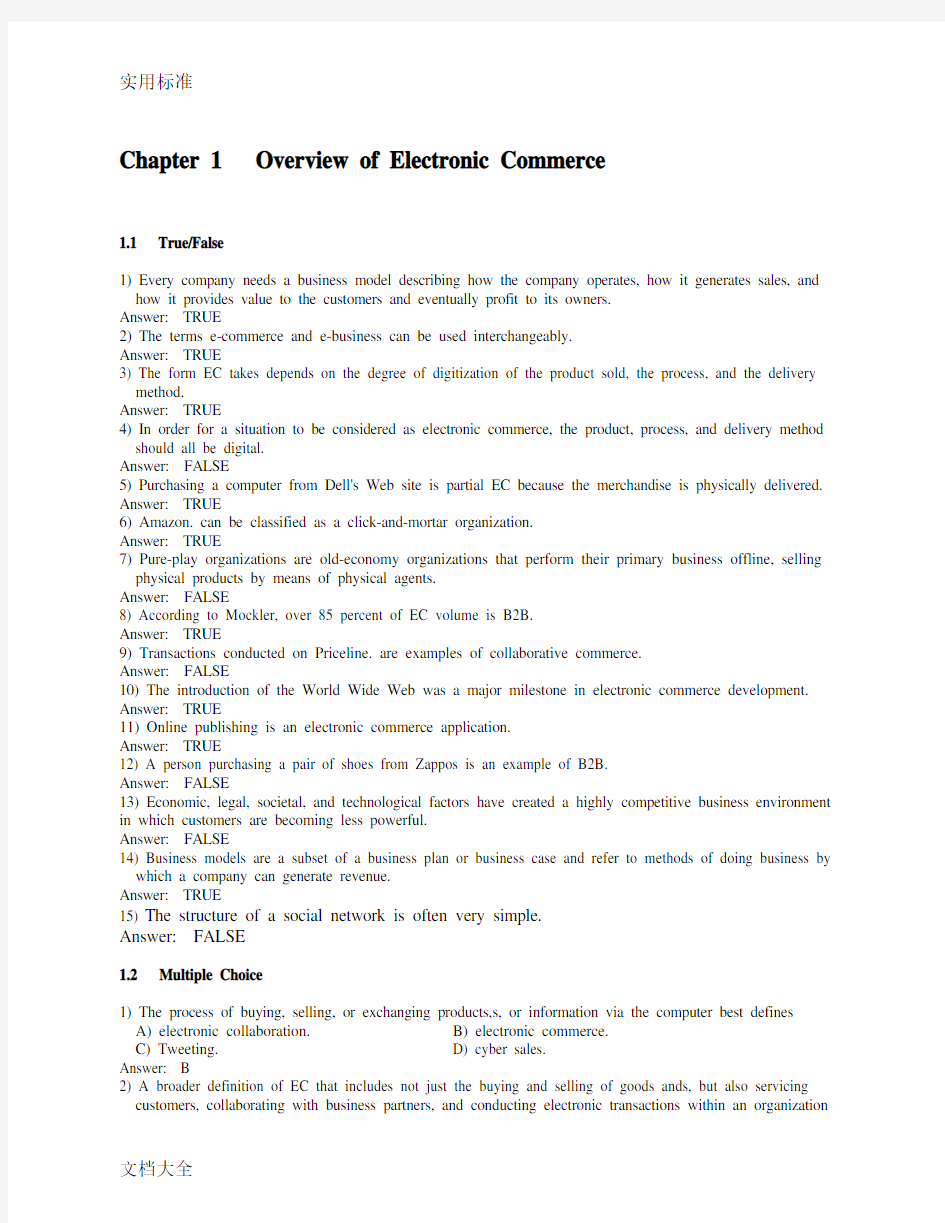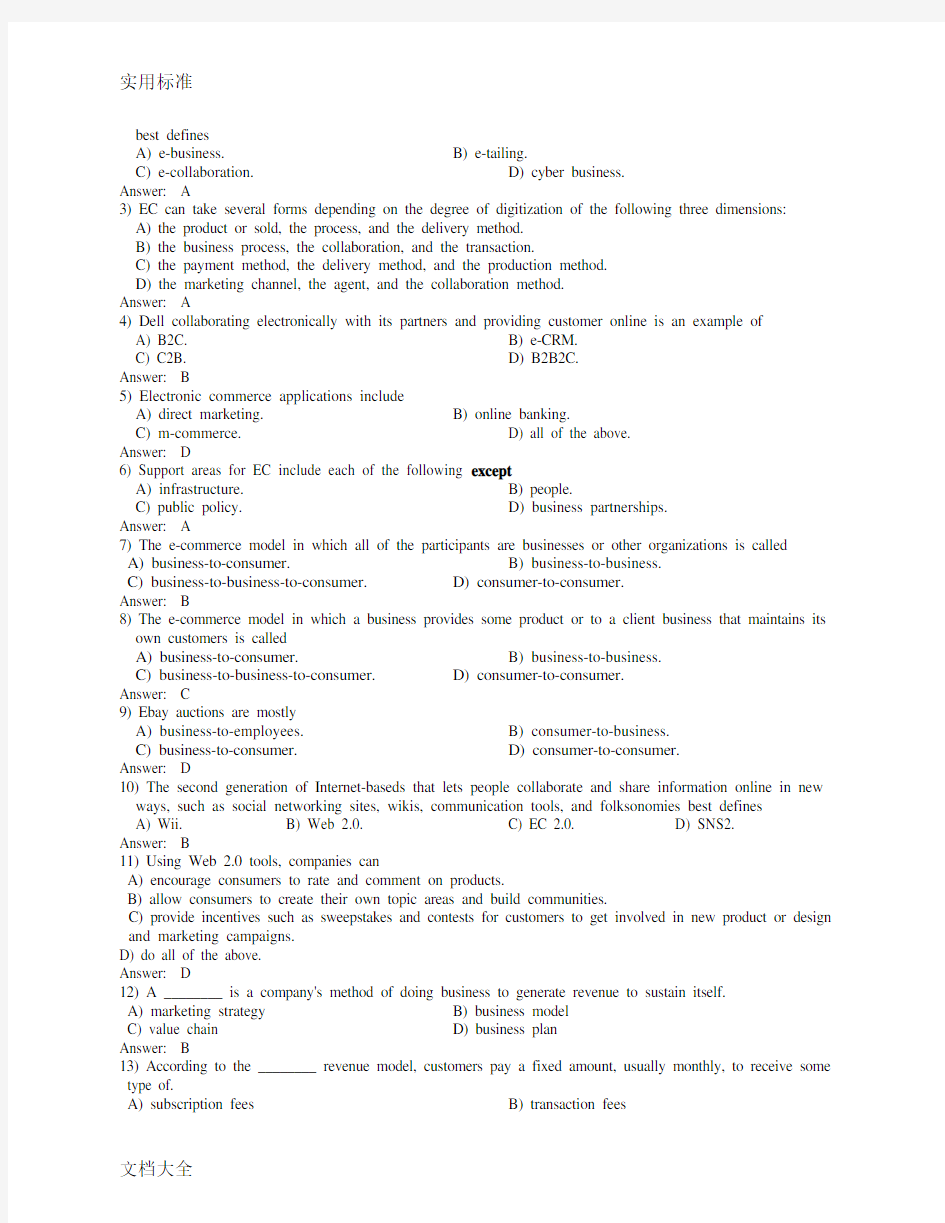

Chapter 1 Overview of Electronic Commerce
1.1 True/False
1) Every company needs a business model describing how the company operates, how it generates sales, and how it provides value to the customers and eventually profit to its owners.
Answer: TRUE
2) The terms e-commerce and e-business can be used interchangeably.
Answer: TRUE
3) The form EC takes depends on the degree of digitization of the product sold, the process, and the delivery method.
Answer: TRUE
4) In order for a situation to be considered as electronic commerce, the product, process, and delivery method should all be digital.
Answer: FALSE
5) Purchasing a computer from Dell's Web site is partial EC because the merchandise is physically delivered. Answer: TRUE
6) Amazon. can be classified as a click-and-mortar organization.
Answer: TRUE
7) Pure-play organizations are old-economy organizations that perform their primary business offline, selling physical products by means of physical agents.
Answer: FALSE
8) According to Mockler, over 85 percent of EC volume is B2B.
Answer: TRUE
9) Transactions conducted on Priceline. are examples of collaborative commerce.
Answer: FALSE
10) The introduction of the World Wide Web was a major milestone in electronic commerce development. Answer: TRUE
11) Online publishing is an electronic commerce application.
Answer: TRUE
12) A person purchasing a pair of shoes from Zappos is an example of B2B.
Answer: FALSE
13) Economic, legal, societal, and technological factors have created a highly competitive business environment in which customers are becoming less powerful.
Answer: FALSE
14) Business models are a subset of a business plan or business case and refer to methods of doing business by which a company can generate revenue.
Answer: TRUE
15) The structure of a social network is often very simple.
Answer: FALSE
1.2 Multiple Choice
1) The process of buying, selling, or exchanging products,s, or information via the computer best defines
A) electronic collaboration. B) electronic commerce.
C) Tweeting. D) cyber sales.
Answer: B
2) A broader definition of EC that includes not just the buying and selling of goods ands, but also servicing customers, collaborating with business partners, and conducting electronic transactions within an organization
best defines
A) e-business. B) e-tailing.
C) e-collaboration. D) cyber business.
Answer: A
3) EC can take several forms depending on the degree of digitization of the following three dimensions:
A) the product or sold, the process, and the delivery method.
B) the business process, the collaboration, and the transaction.
C) the payment method, the delivery method, and the production method.
D) the marketing channel, the agent, and the collaboration method.
Answer: A
4) Dell collaborating electronically with its partners and providing customer online is an example of
A) B2C. B) e-CRM.
C) C2B. D) B2B2C.
Answer: B
5) Electronic commerce applications include
A) direct marketing. B) online banking.
C) m-commerce. D) all of the above.
Answer: D
6) Support areas for EC include each of the following except
A) infrastructure. B) people.
C) public policy. D) business partnerships.
Answer: A
7) The e-commerce model in which all of the participants are businesses or other organizations is called
A) business-to-consumer. B) business-to-business.
C) business-to-business-to-consumer. D) consumer-to-consumer.
Answer: B
8) The e-commerce model in which a business provides some product or to a client business that maintains its own customers is called
A) business-to-consumer. B) business-to-business.
C) business-to-business-to-consumer. D) consumer-to-consumer.
Answer: C
9) Ebay auctions are mostly
A) business-to-employees. B) consumer-to-business.
C) business-to-consumer. D) consumer-to-consumer.
Answer: D
10) The second generation of Internet-baseds that lets people collaborate and share information online in new ways, such as social networking sites, wikis, communication tools, and folksonomies best defines
A) Wii. B) Web 2.0. C) EC 2.0. D) SNS2.
Answer: B
11) Using Web 2.0 tools, companies can
A) encourage consumers to rate and comment on products.
B) allow consumers to create their own topic areas and build communities.
C) provide incentives such as sweepstakes and contests for customers to get involved in new product or design and marketing campaigns.
D) do all of the above.
Answer: D
12) A ________ is a company's method of doing business to generate revenue to sustain itself.
A) marketing strategy B) business model
C) value chain D) business plan
Answer: B
13) According to the ________ revenue model, customers pay a fixed amount, usually monthly, to receive some type of.
A) subscription fees B) transaction fees
C) advertising fees D) affiliate fees
Answer: A
14) Which of the following is not a major revenue model?
A) attributive fee B) sales
C) transaction fees D) subscription fees
Answer: A
15) Large private organizational buyers and government agencies make large-volume or large-value purchases
through ________, also known as reverse auctions.
A) electronic tendering systems B) online direct marketing
C) name-your-own-price models D) viral marketing
Answer: A
1.3 Fill in the Blank
1) ________ is the process of buying, selling, transferring, or exchanging products,s, and/or information via
computer.
Answer: Electronic commerce
2) ________ are organizations that conduct some e-commerce activities, usually as an additional marketing
channel.
Answer: Click-and-mortar organizations
3) ________ describes the hardware, software, and networks used in EC.
Answer: Infrastructure
4) The e-commerce category that includes all internal organizational activities that involve the exchange of
goods,s, or information among various units and individuals in an organization is ________.
Answer: intrabusiness EC
5) ________ is the e-commerce model in which individuals or groups communicate or collaborate online. Answer: Collaborative commerce
6) A ________ is a that builds online communities by providing an online space for people to build free
homepages and that provides basic communication and support tools for conducting different activities in the
social network.
Answer: social network
7) An ________ is a network that uses the Internet to link multiple intranets.
Answer: extranet
8) ________ is a broader definition of EC that includes not just the buying and selling of goods ands, but also
servicing customers, collaborating with business partners, and conducting electronic transactions within an organization.
Answer: E-business
Diff: 3 Page Ref: 28
9) A method of doing business by which a company can generate revenue to sustain itself defines ________. Answer: business model
10) A ________ is a model in which a buyer requests would-be sellers to submit bids; the lowest bidder wins.
Answer: tendering (bidding) system
1.4 Essay
1) List and briefly explain three of the five supports in the electronic commerce framework.
Answer: The five supports are people, public policy, marketing and advertisement, supports, and business
partnerships. The people pillar includes buyers, sellers, intermediaries,, information systems people, and
management. The public policy pillar includes taxes, legal, privacy issues, regulations, compliance, and
technical standards. The marketing and advertisement pillar includes market research, promotions, web content,
and targeted marketing. The supports pillar includes order fulfillment, logistics, payments, content, and security
systems development. The business partnerships pillar includes affiliate programs, joint ventures, exchanges,
e-marketplaces, and consortia.
2) 2) List the five typical EC business models.
Answer: The five typical EC business models are online direct marketing, electronic tendering systems, electronic marketplaces and exchanges, viral marketing, and social networking and Web 2.0 tools.
Chapter 2 E-Marketplaces: Mechanisms, Tools, and Impacts of E-Commerce
2.1 True/False
1) EC enablers include electronic markets, e-stores, and e-catalogs.
Answer: TRUE
2) Storefronts, malls, and portals are EC mechanisms that support the entertainment EC activity. Answer: FALSE
3) The emergence of electronic marketplaces has resulted in lower information search costs for buyers and lower transaction and distribution costs for sellers.
Answer: TRUE
4) Although both marketplaces and marketspaces can sell physical products, the marketspace can also sell digital products.
Answer: TRUE
5) An intermediary is a third party that operates between sellers and buyers.
Answer: TRUE
6) Travelers using airline Web sites to book their flights directly without the use of travel agents is resulting in the reintermediation of travel agents.
Answer: FALSE
7) Electronic storefronts, Internet malls, and exchanges are major B2B e-marketplaces. Answer: FALSE
8) Brokers and infomediaries are two types of online intermediaries.
Answer: TRUE
9) Search engines not only "search and match," but also have capabilities that can be used to perform routine tasks that require intelligence.
Answer: FALSE
10) An electronic shopping cart is an order-processing technology that allows customers to accumulate items they wish to buy while they continue to shop.
Answer: TRUE
11) Shopping carts for B2B are fairly simple, but a shopping cart for B2C may be more complex. Answer: FALSE
12) An auction is a market mechanism that uses a competitive process by which a seller solicits consecutive bids from buyers or a buyer solicits bids from sellers.
Answer: TRUE
13) Auctions are based on dynamic pricing.
Answer: TRUE
14) Reverse auctions are bidding or tendering systems in which the buyer places an item for bid on
a request for quote system; then potential suppliers bid on the job, with the price reducing sequentially, and the lowest bid wins.